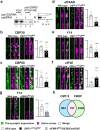CMTr cap-adjacent 2'-O-ribose mRNA methyltransferases are required for reward learning and mRNA localization to synapses
- PMID: 35260552
- PMCID: PMC8904806
- DOI: 10.1038/s41467-022-28549-5
CMTr cap-adjacent 2'-O-ribose mRNA methyltransferases are required for reward learning and mRNA localization to synapses
Abstract
Cap-adjacent nucleotides of animal, protist and viral mRNAs can be O-methylated at the 2' position of the ribose (cOMe). The functions of cOMe in animals, however, remain largely unknown. Here we show that the two cap methyltransferases (CMTr1 and CMTr2) of Drosophila can methylate the ribose of the first nucleotide in mRNA. Double-mutant flies lack cOMe but are viable. Consistent with prominent neuronal expression, they have a reward learning defect that can be rescued by conditional expression in mushroom body neurons before training. Among CMTr targets are cell adhesion and signaling molecules. Many are relevant for learning, and are also targets of Fragile X Mental Retardation Protein (FMRP). Like FMRP, cOMe is required for localization of untranslated mRNAs to synapses and enhances binding of the cap binding complex in the nucleus. Hence, our study reveals a mechanism to co-transcriptionally prime mRNAs by cOMe for localized protein synthesis at synapses.
© 2022. The Author(s).
Conflict of interest statement
The authors declare no competing interests.
Figures






Similar articles
-
CMTr mediated 2'-O-ribose methylation status of cap-adjacent nucleotides across animals.RNA. 2022 Oct;28(10):1377-1390. doi: 10.1261/rna.079317.122. Epub 2022 Aug 15. RNA. 2022. PMID: 35970556 Free PMC article.
-
The cap epitranscriptome: Early directions to a complex life as mRNA.Bioessays. 2023 Mar;45(3):e2200198. doi: 10.1002/bies.202200198. Epub 2022 Dec 18. Bioessays. 2023. PMID: 36529693
-
Metabotropic glutamate receptors and fragile x mental retardation protein: partners in translational regulation at the synapse.Sci Signal. 2008 Feb 5;1(5):pe6. doi: 10.1126/stke.15pe6. Sci Signal. 2008. PMID: 18272470 Review.
-
Tracking the Fragile X Mental Retardation Protein in a Highly Ordered Neuronal RiboNucleoParticles Population: A Link between Stalled Polyribosomes and RNA Granules.PLoS Genet. 2016 Jul 27;12(7):e1006192. doi: 10.1371/journal.pgen.1006192. eCollection 2016 Jul. PLoS Genet. 2016. PMID: 27462983 Free PMC article.
-
Identification of messenger RNAs and microRNAs associated with fragile X mental retardation protein.Methods Mol Biol. 2006;342:267-76. doi: 10.1385/1-59745-123-1:267. Methods Mol Biol. 2006. PMID: 16957381 Review.
Cited by
-
Dynamically expressed single ELAV/Hu orthologue elavl2 of bees is required for learning and memory.Commun Biol. 2021 Oct 28;4(1):1234. doi: 10.1038/s42003-021-02763-1. Commun Biol. 2021. PMID: 34711922 Free PMC article.
-
Cap-adjacent 2`-O-ribose methylation of RNA in C. elegans is required for postembryonic growth and germline development in the presence of the decapping exonuclease EOL-1.bioRxiv [Preprint]. 2025 May 12:2025.03.10.638824. doi: 10.1101/2025.03.10.638824. bioRxiv. 2025. PMID: 40654955 Free PMC article. Preprint.
-
Gene-based burden tests of rare germline variants identify six cancer susceptibility genes.Nat Genet. 2024 Nov;56(11):2422-2433. doi: 10.1038/s41588-024-01966-6. Epub 2024 Oct 29. Nat Genet. 2024. PMID: 39472694
-
Memory consolidation in honey bees is enhanced by down-regulation of Down syndrome cell adhesion molecule and changes its alternative splicing.Front Mol Neurosci. 2024 Jan 9;16:1322808. doi: 10.3389/fnmol.2023.1322808. eCollection 2023. Front Mol Neurosci. 2024. PMID: 38264345 Free PMC article.
-
CMTr mediated 2'-O-ribose methylation status of cap-adjacent nucleotides across animals.RNA. 2022 Oct;28(10):1377-1390. doi: 10.1261/rna.079317.122. Epub 2022 Aug 15. RNA. 2022. PMID: 35970556 Free PMC article.
References
-
- Zaccara S, Ries RJ, Jaffrey SR. Reading, writing and erasing mRNA methylation. Nat. Rev. Mol. Cell Biol. 2019;20:608–624. - PubMed
-
- Roignant JY, Soller M. m6A in mRNA: an ancient mechanism for fine-tuning gene expression. Trends Genet. 2017;33:380–390. - PubMed
-
- Livneh I, Moshitch-Moshkovitz S, Amariglio N, Rechavi G, Dominissini D. The m(6)A epitranscriptome: transcriptome plasticity in brain development and function. Nat. Rev. Neurosci. 2020;21:36–51. - PubMed
Publication types
MeSH terms
Substances
Grants and funding
- BB/L006340/1/BB_/Biotechnology and Biological Sciences Research Council/United Kingdom
- BB/R001715/1/BB_/Biotechnology and Biological Sciences Research Council/United Kingdom
- BB/M017982/1/BB_/Biotechnology and Biological Sciences Research Council/United Kingdom
- BB/R002932/1/BB_/Biotechnology and Biological Sciences Research Council/United Kingdom
- WT_/Wellcome Trust/United Kingdom
LinkOut - more resources
Full Text Sources
Medical
Molecular Biology Databases
Miscellaneous

